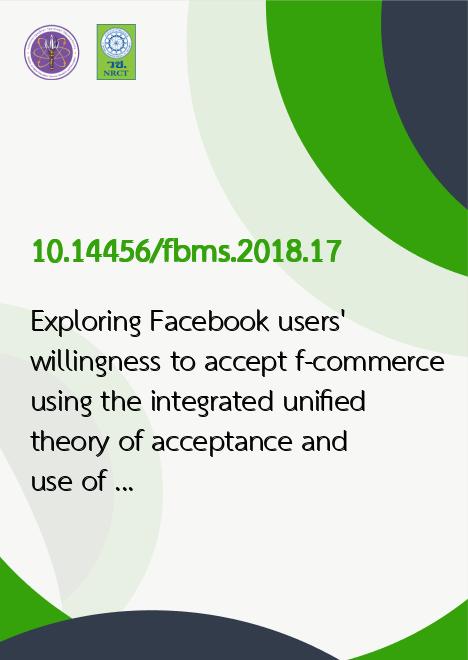
|
Exploring Facebook users' willingness to accept f-commerce using the integrated unified theory of acceptance and use of technology 2 (UTAUT2), trust and risk under the moderating role of age and gender |
|---|---|
| รหัสดีโอไอ | |
| Creator | Anny Mardjo |
| Title | Exploring Facebook users' willingness to accept f-commerce using the integrated unified theory of acceptance and use of technology 2 (UTAUT2), trust and risk under the moderating role of age and gender |
| Publisher | University of the Thai Chamber of Commerce |
| Publication Year | 2561 |
| Journal Title | UTCC International Journal of Business and Economics |
| Journal Vol. | 10 |
| Journal No. | 2 |
| Page no. | 139-166 |
| Keyword | UTAUT2, Perceived risk, Trust, Facebook, f-commerce, s-commerce |
| URL Website | http://ijbejournal.com/ |
| Website title | ijbejournal |
| ISSN | 1906-5582 (paper) |
| Abstract | What are the factors that influence consumers' intention to participate in Facebook commerce (f-commerce)? Are the factors the same across all ages and genders? To answer these questions, I i) developed a theoretical framework based on the Unified Theory of Acceptance and Use of Technology 2 (UTAUT2) model, Trust and Risk, ii) tested the proposed model using Partial Least Squares Structural Equation Modelling, and (iii) interpreted and considered the implications of the results. The results show that consumers' trust in Facebook, performance expectancy, and perceived risk have significant impacts on their purchasing decisions. For young adults (aged 18-24 years old), trust has more influence on behavior intention while performance expectancy has a greater role among working adults (25-32 years old). Although facilitating conditions and habits do not have a significant relationship to behavior intention, their influences vary among females and males. Among females, the influence of facilitating conditions is more significant on behavior intention, while the effect of habits is more influential among males. Nevertheless, the differences among these groups are not significant, thus the findings can be applied to practically any group and e-vendors are not require to create separate programs to accommodate each group. |